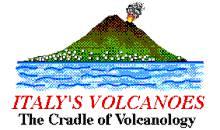 |
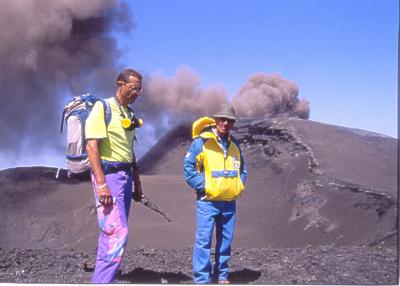 |
|
Giuseppe
("Pippo") Scarpinati (left) and Salvatore ("Turi")
Ragonese (mountain guide on Etna's N flank) on the E rim of the
Voragine, with the NE Crater emitting brown ash in the background
on 23 August 2000. Scarpinati holds a long bomb ejected from the
SE Crater during the spring of 2000
|
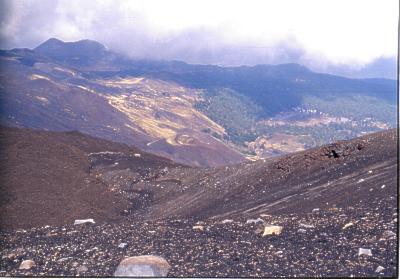 |
|
A
view down the so-called Northeast Rift of Etna towards N, showing
some landmarks on the NNE flank of the volcano (click on image to
see large version with explanations). The Northeast Rift is an area
where eruptive fissures, craters and cones from flank eruptions
are densely concentrated, creating a morphological ridge (at left).
In spite of this unusual accumulation of eruptive vents, flank eruptions
do not take place in this area more frequently than anywhere else
on Etna
|
Photos
of Etna, September 2000
|
 |
These are the
first new images of Etna to be posted on this web site after a long pause.
They show the situation at the summit craters in late August to late September
2000. More photos, also of July 2000, will be added.
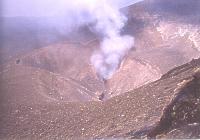 |
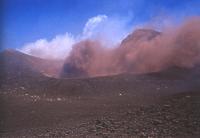 |
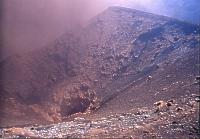 |
|
Left:
A view into the E vent of the Bocca Nuova (also called "1964
vent") from SE on 23 August 2000. At that time this vent had
two funnel-shaped pits (visible in the foreground and to the left
of the white gas column), and one small open pit from which strong
degassing occurred, accompanied by deep explosion sounds.
Center: Noiseless emission of brownish ash from the E vent of the
Bocca Nuova on 29 August 2000. These emissions were caused by material
sliding from the vent walls into the conduit, from which they were
re-ejected by the continuous gas stream.
Right: View into the inactive westernmost of the pits within the
E vent of the Bocca Nuova on 29 August 2000. The hole at the bottom
of the pit was incandescent in mid February 2000, and some of the
many thousands of the spectacular gas rings produced between February
and July 2000 were emitted from this hole.
|
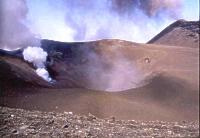 |
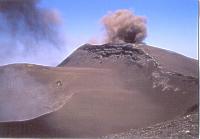 |
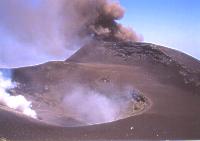 |
|
The
three photos above show the Voragine and the NE Crater as seen from
the SE rim of the Voragine on 23 August 2000. Large central pit
of the Voragine is visible in left and right frames, emitting a
dilute gas plume, while the smaller and more recent vent on its
N side is seen emitting a dense column of white gas. Note flat floor
of the Voragine around the central vent. The NE Crater is visible
in the background in the center and right frames, emitting plumes
of brown ash. Note steep flank of the NE Crater cone toward the
Voragine, formed by collapse during the two powerful Voragine eruptions
on 22 July 1998 and 4 September 1999.
|
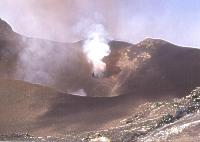 |
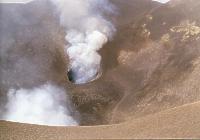 |
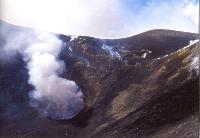 |
|
Left:
Wide angle view of the Voragine from N on 23 August 2000. The rim
of the central pit is visible in the lower middle ground, and a
white gas plume is being emitted from the small vent on its S rim.
Behind the crest visible behind and to the left of the dense white
gas plume lies the Bocca Nuova.
Center: Zoom on the small S vent of the Voragine on 23 August 2000.
Central vent is visible in the foreground.
Right: S vent of the Voragine on 27 September 2000. Gas emission
is less vigorous than one month earlier, but mild Strombolian activity
has begun a few days earlier at the E vent of the Bocca Nuova, which
lies behind the crest in the background.
|
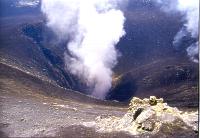 |
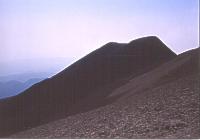 |
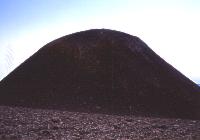 |
|
Left:
A look into the central pit of the Voragine from its NW rim on 27
September 2000. On that day gas emission from this vent was more
vigorous than during the 23 August visit. Smaller S vent is at extreme
right of the photo.
Center: The cone of the SE Crater seen from the E rim of the Voragine
on 23 August 2000. The fissure on the NNE side of the cone is at
extreme left, a low hummock is visible at the lowermost vents at
left. Photo has high contrast due to sun standing right above the
SE Crater. Note complete absence of gas emission from the cone and
the fissure.
Right: The SE Crater cone seen from the terrace of the former Central
Crater (to the SE of the Bocca Nuova) on 23 August 2000. Illumniation
was bad when photo was taken, but the dimensions of the cone are
visible.
|
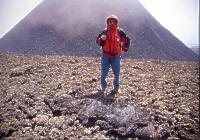 |
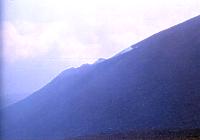 |
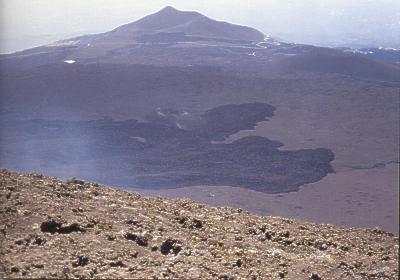 |
|
Left:
2 m long bomb ejected from the SE Crater (background) during its
paroxysm on 28 August 2000, which fell on the terrace SE of the
Bocca Nuova. Photo was taken on 29 August, just a few hours after
another but smaller paroxysm from the SE Crater, which did not throw
any ejecta onto the platform. Person behind bomb gives scale.
Center: Zoom on the lower part of the eruptive fissure on the NNE
flank of the SE Crater cone (whose flank is visible at right), showing
small cones that grew during the latest two paroxysms on 28 and
29 August 2000. Photo was taken a few hours after the latter of
the two events, when there was still gas emission from the lower
part of the fissure. View is from the E rim of the Voragine towards
SE.
Right: View toward S from the old Central Crater platform on 29
August 2000, showing the most recent lava flows erupted from the
SE Crater onto the plain at its SW base as dark lobes. These flows
were erupted in June 2000, extending only a few hundred meters from
the base of the cone. Lavas erupted between late January and May
2000 were covered with a thick sheet of scoriae during SE Crater
paroxysm during late May and early June when winds were blowing
S and SW. White dot at upper left is the Torre del Filosofo mountain
hut. The Montagnola, a large pyroclastic cone formed during a 1763
flank eruption, is visible in the distance, with the building of
the upper cable car station near its right base.
|
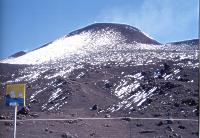 |
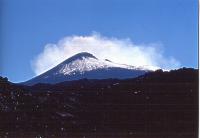 |
|
Left:
The cone of the NE Crater seen from W on 27 September 2000, two
days after a light snowfall. The high curved ridge, the SW rim of
the NE Crater, is presently the highest point on Etna. Small eminence
at extreme left is the N rim of the crater, which is almost equally
high, but appears significantly lower in this perspective. In the
foreground is the tourist lookout for those who arrive near the
summit from N (Piano Provenzana), rope marks the beginning of the
restricted area while the sign at left describes what can be seen
from this point.
Right: The NE Crater cone seen from N on 27 September 2000. In this
perspective the N rim of the crater forms the high point of the
cone, while the (slightly higher) SW rim appears as a small black
knob further right.
|

Yes,
there's an ad on this page. This is related to a counter system I use
to obtain web statistics and furthermore it's there to let me receive
a minor economic input for this site which has become more and more extensive,
and still work on this site is being done by myself exclusively (except
taking some of the photos). I hope no one is offended by this commercial
bit, but rather click on the banner to help me keep the site alive.
|
